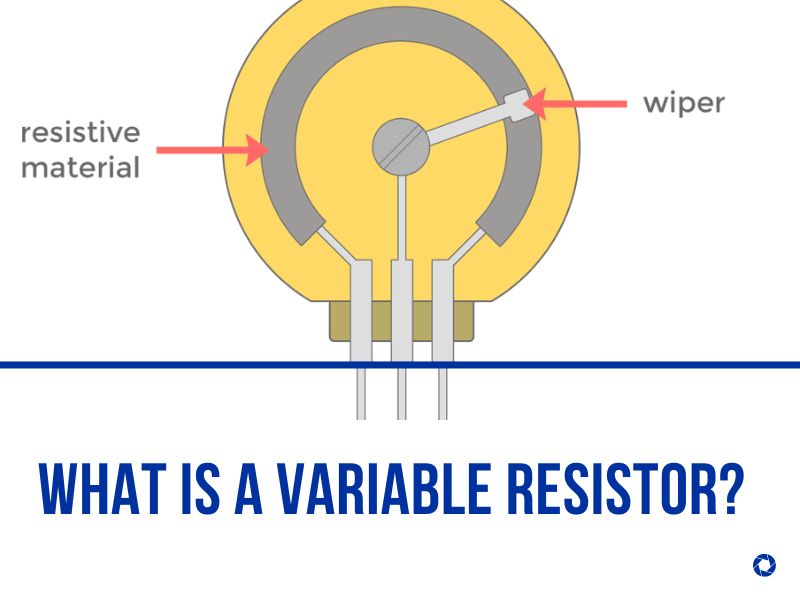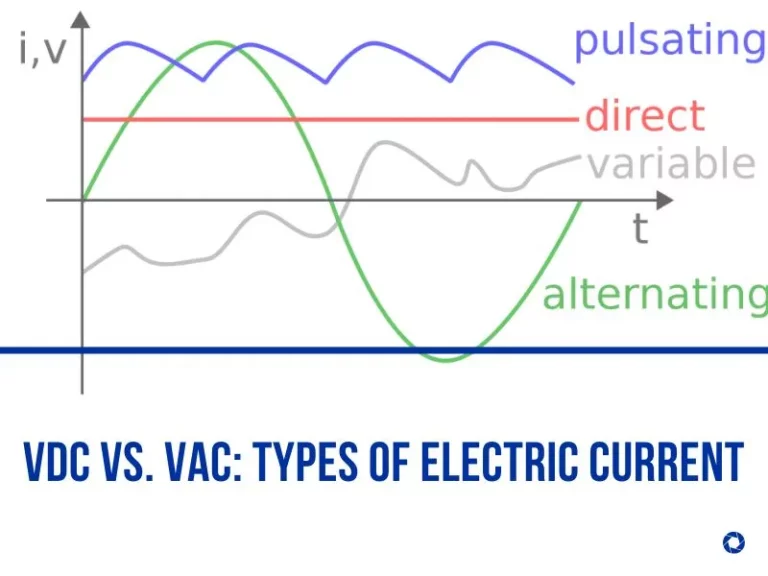What Is A Variable Resistor?
A resistor whose electric resistance value can be changed is referred to as a variable resistor. A variable resistor, which functions typically by gliding a contact (wiper) over a resistive element, is essentially an electro-mechanical transducer.
In other words, the variable resistor is a passive, three-terminal device whose third terminal, which is positioned in between the other two, can change its resistance, thereby changing the resistance to the flow of current. As a result, the variable resistor circuit symbol has an arrow that symbolizes the variation in resistance.
How does a variable resistor work?
(A) shaft,
(B) stationary carbon composition resistance element,
(C) phosphor bronze wiper,
(D) shaft attached to the wiper,
(E, G) terminals connected to ends of resistance element,
(F) terminal connected to the wiper. A mechanical stop
(H) prevents rotation past endpoints.
A wiper (C) that slides over this resistive element when rotated creates electrical contact makes up the majority of low-cost potentiometers. The resistive element (B in the cutaway drawing) is formed into an arc of a circle, typically slightly less than a full turn. Both flat and angled resistive elements are possible.
A terminal (E, G) on the case is connected to each end of the resistive element. A third terminal (F), typically in between the other two, is where the wiper is connected.
The wiper terminal on panel potentiometers is typically the middle of three terminals. This wiper typically makes just under one complete rotation around the contact in single-turn potentiometers. The confined area between the rotating shaft and the housing is the only point of entry for contamination.
What are the types of variable resistors?
Potentiometer
A potentiometer is what is used when a variable resistor with three terminals is used as a potential divider. It operates as a variable resistance and is known as a rheostat when only two terminals are present.
It is possible to control variable resistors electronically rather than mechanically thanks to the existence of such devices. Digital potentiometers are the name given to these resistors.
Rheostat
A rheostat is a variable resistor that regulates the current flow. They are able to continuously change the resistance in a circuit. Potentiometer construction is strikingly similar to this one. Even though there are three terminals (like in a potentiometer), it only uses two connections.
The resistive element’s one end is connected to the first device, and the wiper is connected to the second device (sliding contact). Rheostats require more current to be carried than potentiometers do.
Digital Resistors.
By connecting the digital and analog resistor worlds, digital potentiometer integrated circuits, or digipots, provide a solution to these problems.
Digipots are an entirely electronic component that is compatible with microcontrollers, allowing a processor and software to regulate, set, and change the resistance value or voltage divider ratio.
As they don’t have moving wipers, they are more durable and reliable and offer features and functions that mechanical devices cannot. They cannot be accidentally or purposefully modified, preventing unexpected performance changes.
To name a few, applications include Wheatstone bridge trims for sensors, controlling current sources, and tuning programmable analog filters. Other examples include LED thermal stabilization, LED dimming, closed-loop gain control, audio volume adjustment, calibration, and Wheatstone bridge trims.
The use of a digipot is much more complicated than that of a straightforward mechanical potentiometer, and there are numerous restrictions to be aware of. Despite this, they are frequently used for equipment calibration and factory adjustment, particularly in situations where mechanical potentiometer restrictions are problematic.
Like other semiconductor devices, a digipot is typically resistant to the effects of mild long-term mechanical vibration or environmental contamination.
A digipot can also be electronically secured against unauthorized tampering by using various methods to restrict access to its programming inputs.
1/4 Vs 1/2 Watt Resistor: Which One Is Better For Your Project?
rlc talk
What is a variable resistor used for?
By connecting the digital and analogue resistor worlds, digital potentiometer integrated circuits, or digipots, provide a solution to these problems. Digipots are an entirely electronic component that is compatible with microcontrollers, allowing a processor and software to regulate, set, and change the resistance value or voltage divider ratio.
These tools are used because they aid in controlling voltage and/or current when working with electrical circuitry. They are specifically concerned with the circuit’s voltage and currents. These devices’ adjustability is fairly straightforward.
A wiper contact that can be moved up and down the resistance track is included with each resistor. It is necessary to adjust the resistor at the current values in order to construct the circuit.
Later, adjustments can be made using a connected control knob. The wiper contact and its location on the resistance track determine the variable resistor’s resistance value.
Although used in various industries, a variable resistor is utilized in a manner that is quite similar. These devices serve as rheostats. In other words, they aid in completing circuit connections while leaving the resistance track open.
A variable resistor is used as a potentiometer when the inputs of circuits are connected to the ends of the resistor track. All three of the device’s terminals are utilised when operating as a potentiometer. These resistors come in a variety of types depending on their intended use.
In radios.
Variable resistors are found in boomboxes and radios that you may have in your car, house, or even hanging over your shoulder. Although you might not be able to see it, a variable resistor is operating behind those volume knobs.
The radio controls how many volts are output to your speakers because it is the hub for your audio system. Your speakers will become louder as more voltage is applied, and quieter as less voltage is applied.
In light dimmers.
Another device that makes use of variable resistors is the light dimmer. Homes frequently have light dimmers. A light dimmer’s job is to adjust the brightness of the circuit’s connected bulbs.
By regulating the voltage, and more specifically the wattage output to the bulbs, the dimmer achieves this. The brightness of the bulbs will increase as more voltage is allowed to enter them, and vice versa.
Controller for Fan Speed
We are all accustomed to the rotating knob that regulates the fan speed. The potentiometer’s rotating knob alters how much resistance is present.
- Numerous household appliances and electronics use variable resistors. Radios, speakers, microphones, TVs, oscillators, smart home control devices, etc. are a few of these. In most home electronic appliances where speed or volume level control is required, potentiometers are used.
- When adjusting current or resistance levels, rheostats are used. The dimming of lights is a typical illustration. In conclusion, variable resistors are widely used in applications that call for current or voltage adjustment.
What are the characteristics of a variable resistor?
The relationship between the resistance ratio and the mechanical position of the moving terminal defines the variable resistor’s most crucial feature. The resistor is labeled as having a taper. Typically, only two types of taper—linear and logarithmic taper—are marked.
The resistance ratio will directly relate to the mechanical position because linear taper denotes a linear relationship between the two. This will result in a straight line with a constant slope when plotted on a graph.
Before selecting a resistor for a particular application, one must be aware of another crucial variable resistor feature. It is referred to as the resistor’s resolution. The smallest resistance value that a variable resistor can change is what is referred to as the resolution.
The smallest value by which the resistance changes in a variable resistor with a resolution of 0.005 is 0.005 ohm. A variable resistor’s high resolution is a positive quality.
How do variable resistors reduce voltage?
Simply by creating a voltage divider circuit with two resistors of equal value (for instance, two 10K resistors), we can cut the voltage in half.
All you need to do to divide voltage in half is connect any two resistors of equal value in series with a jumper wire.
What happens to voltage when the variable resistor is increased?
Now, thanks to Ohm’s law, which states that the potential difference across the circuit is precisely proportional to the current flowing in the circuit, the variable resistor’s resistance will grow as the voltmeter reading in the voltmeter P increases. The V value at P now rises as r value does.
Advantages and disadvantages of variable resistors.
Variable resistors have the benefit of giving you greater control over voltage. Additionally, you can modify the voltage that passes through a circuit.
Variable resistors have the drawback that you need them in specific locations, which means that if you want to divide the circuit into different parts, you would need more parts. Additionally, variable resistors are ineffective anywhere there is vibration.







